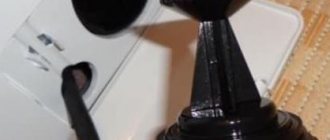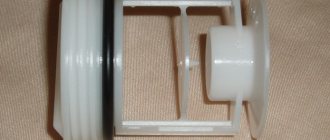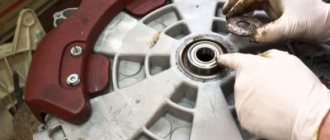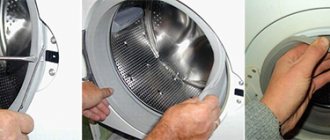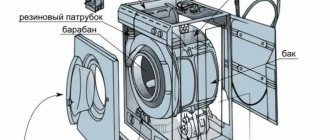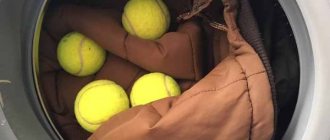When is cleaning necessary?
The filter needs to be cleaned as it gets dirty. Experts recommend performing this procedure for preventive purposes once every 2-3 months.
For Diamond series devices, you need to clean the filter at least 5-6 times a year. The more actively household appliances are used, the more often the procedure should be carried out .
Provided that an animal lives in the house, these deadlines are shifted. As practice shows, the filter needs to be cleaned after every 10-15 washing cycles.
If you ignore the advice, then one day the filter will clog. The machine will not be able to drain the water in the usual way and will have to carry out this procedure in emergency mode. In this case, the error code, 5C or will be displayed on the screen.
Error E2 is typical for those machines that were released before 2007 . Other codes appear on more modern models. Error 5E and E5 should not be confused. Code E5 indicates a malfunction in the water heating system, and not a clogged filter.
Not all Samsung washing machines are equipped with a screen. If it is not there, then a clogged filter will be indicated by a burning 40 degree indicator and flashing lights in all operating modes. If there is no error, but the part is clogged, the water after washing will drain more slowly than usual.
An unpleasant odor emanating from the washing machine may indicate that a blockage has formed. It becomes especially intense if the device is not used for several days.
Where is the filter element located?
The cleaner is located at the bottom of the Samsung washing machine. In devices with horizontal loading, it is located on the front wall, at the bottom right side.
The part is covered with a rectangular cover . If the machine was produced a long time ago, then the pump can be found under a removable plastic false panel.
In top-loading appliances, the filter can be found under the panel at the bottom, on one of the sides. However, such models are rarely found in Russian stores.
Where is the filter located in a Samsung washing machine?
Modern washing machines have two types of devices that purify water.
- Fill filter. Located at the entrance to the machine behind the intake hose. Serves to retain small particles of debris, rust, sand, scale, which come from the public water supply.
- Drain or drain. Located at the bottom of the front panel. Protects the drain pump and the rest of the system from foreign objects. For example, when washing, coins, buttons and other items forgotten in pockets may end up in the tub. All this ends up in the drain and disables the pump and damages the pipes. Fortunately, the filter traps most of the debris.
Getting to the details is not difficult. To understand that operating problems are related to a clogged system, pay attention to the signs.
Preparing for cleaning
Before you begin the main procedure, you need to perform a number of preparatory steps:
- Turn off the water supply tap.
- Disconnect the device from the network. This is a mandatory condition to avoid electric shock.
- Prepare the tools needed for cleaning.
- Using a screwdriver, coin or knife with a rounded end, pry off the hatch cover that covers the part.
- Holding the protrusion on the filter, turn it counterclockwise 60 degrees and wait until the water drains out.
This completes the preparation. You can take out the part and start cleaning. The recess into which the filter is screwed is called a snail niche.
Instructions
By following the step-by-step instructions for cleaning the filter, you will be able to quickly cope with the task. Having successfully carried out this procedure once, it will not cause difficulties in the future.
What tools are needed?
To carry out the work you will need the following tools:
- old toothbrush;
- slotted screwdriver;
- pliers;
- a rag or container for collecting water;
- flashlight;
- tweezers or small scissors;
- citric acid and water.
Cleaning process
The cleaner is unscrewed using a rotational motion. You need to turn it counterclockwise. If cleaning is carried out in emergency mode, it is necessary to lay a rag to prevent water from spreading across the floor.
The procedure for cleaning the debris trap does not always go smoothly . When carrying out this procedure, you may encounter the fact that the part cannot be removed the first time. Most often this happens when it is rarely removed. Scale or foreign objects may prevent removal.
To avoid damaging the filter, gently tap the filter cover. If this does not help, use pliers. To avoid breaking the ledge, you need to control the pressure. Rotate them carefully, without sudden movements.
Another way to remove the filter from the niche is to remove the drain pump. However, this process is more labor-intensive and difficult to cope with on your own.
When the filter is in your hands, it must be rinsed under running water. It is recommended to use an old toothbrush to remove dirt and debris . If the hair and threads are very tangled in the mesh, you can use nail scissors and carefully trim them.
When the part is cleaned, there is no need to rush to return it to its place. You should take a flashlight and shine it into the hole from which it was removed. Having found the impeller of the drain pump, remove debris from it and remove wound hair and threads. To do this, you can use tweezers.
When the dirt is removed, put the filter back, twisting it clockwise. It must be screwed tightly . After completion of work, close the lid.
If there is a lot of scale and mold on the filter, you can remove it with citric acid. The part is soaked in a weakly concentrated solution for 2 hours. After this treatment, the mesh is washed with clean water.
Example for Samsung Diamond washing machine
Instructions are always more understandable if they are analyzed using a specific example . A step-by-step algorithm for dealing with emergency drainage is considered for the Samsung Diamond washing machine model:
- Open the hatch behind which the purifier is hidden.
- Remove the drain tube from the hook and pull it out.
- Remove the plug from the hose and drain the water.
- Install the plug and return the hose to its place.
- Proceed to clean the filter according to the instructions given above.
Step by Step Actions
The procedure for cleaning the catch filter in a washing machine is simple and does not require great skills or special tools.
Tools and equipment
You need to prepare in advance and have simple equipment and tools on hand:
- A flat-head screwdriver (minus), a rounded cutlery knife, or a coin.
- Pliers or pliers.
- A low but wide reservoir for draining water.
- A rag.
- Flashlight.
On forums, some users share videos of their experience using a regular plastic garbage bag instead of a container, draining so that not a single drop remains on the floor.
Preparing for cleaning
In order to clean the filter assembly, you will need to perform some preparatory work common to all washing machines:
- turn off the water to the machine;
- disconnect the device from the power supply;
- using a screwdriver or other device, carefully pry and open the cover of the hatch in which the debris catcher is installed;
- Using the handle on the lid, turn it 45-60o counterclockwise and drain the remaining water in the system.
After this, you can completely unscrew and remove the debris catcher from the snail niche.
Troubleshooting Possible Problems
Often at this stage it becomes difficult to unscrew the drain filter. The causes of the problem may be:
- Irregularity of preventive cleaning of the unit.
- Scale formation on threads.
- Blocking of the catcher by foreign objects.
In these cases, there are simple methods that can help solve the stuck filter problem:
- tilt the washer slightly away from you and tap the filter cover with a gloved hand;
- try using pliers or pliers to unscrew the part.
To avoid breaking the plastic handle on the lid, clamp it with pliers and turn it carefully, without excessive force.
If you still cannot unlock the filter or it unscrews but cannot be removed from the niche, then there is another, more complicated method - dismantling the drain pump.
If there is no relevant experience, then the work of removing the snail with the pump should be entrusted to a specialist.
Process
The step-by-step cleaning procedure looks like this:
- Remove all foreign objects and deposits from the filter niche and wipe it clean.
- Use a flashlight to make sure the snail is completely cleaned.
- Use a rag, toothbrush or sponge to remove heavy dirt and scale from the filter itself.
- Wash the part well under running hot water.
- Put the filter in place.
To make it easier to remove mold or scale, you can use citric acid or soda dissolved in equal parts of water.
Example on a Samsung Diamond washing machine
More specific instructions for cleaning the drain filter can be seen using the example of a Samsung Diamond washing machine. The devices may have an emergency drain.
If you are forced to stop washing due to problems with water drainage, you must:
- Lift and open the cover of the hatch behind which the filter is located.
- Remove from hook and pull out drain tube.
- Remove the plug from the hose.
- Drain the water.
- Place the plug and secure the drainage tube in place.
For preventive cleaning of the Diamond washing machine filter, before removing it, the remaining water in the drain system is also pre-drained according to the emergency drain scheme given above.
The further procedure and sequence of actions for servicing the garbage trap are the same as for most automatic washing machines.
What problems might you encounter?
If a puddle of water forms on the floor after cleaning, this indicates the following problems:
- the part is not completely screwed in;
- during its installation, there was a misalignment in the threaded connection;
- The elastic band acting as a gasket was damaged.
The first two problems can be quickly resolved by reinstalling the filter. If the cause is hidden in a damaged seal, it must be replaced.
The worst thing is if the thread breaks when trying to remove the filter. In this case, you will need to replace the pump volute or the filter itself.
You will find all the most important and useful information about Samsung washing machines in this section of the site.
Typical causes of blockage
A blockage in the drainage hose of a Samsung washing machine is inevitable - particles of washing powder, hair, and lint from things will, one way or another, settle on the walls of the element. This clogging is more than natural for any automatic machine, regardless of the brand and model. Users have the power to slow down pollution; to do this, it is enough to follow the following recommendations:
- wash clothes in special bags;
- use a tap water softener;
- after completing the washing cycle, run the machine “idle” to rinse the insides of the unit;
- take proper care of the machine;
Experts recommend carrying out a comprehensive cleansing of the SMA once every 3 months.
- use high-quality washing powders and gels designed specifically for automatic machines;
- check the pockets of items for debris, clean hair from laundry, shake out clothes before loading them into the drum.
Don't neglect cleaning the drain hose. It takes 10 minutes to clean the element. But this will help the machine continue to perform its functions.
Interesting:
- Rating of Samsung washing machines
- Repairing the water supply valve in a washing machine
- How to repair a Samsung washing machine
- Check valve for washing machine - review
- Reviews of Samsung washing machines
- How to change the drain hose in an Ariston washing machine?
Reader comments
- Share your opinion - leave a comment
